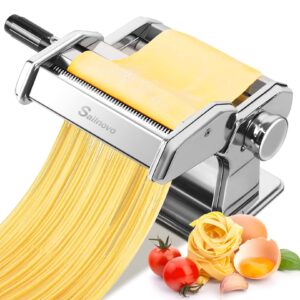
When it comes to choosing a pasta maker, one of the most important decisions you’ll have to make is what material it should be made of. Pasta makers come in a variety of materials, but the two most common are stainless steel and plastic.
Stainless Steel Pasta Makers
Stainless steel pasta makers are a popular choice among home cooks and professional chefs alike. They are durable, easy to clean, and offer excellent performance. Stainless steel pasta makers are made of high-quality steel that’s resistant to rust and corrosion, meaning they will last for years with proper care and maintenance. They also have a sleek, modern look that can add a touch of style to any kitchen.
One of the biggest advantages of using a stainless steel pasta maker is its durability. Stainless steel is a sturdy material that can withstand heavy use, making it perfect for those who want to make pasta regularly. Stainless steel pasta makers are also easy to clean and maintain, and they don’t absorb odors or flavors, meaning they won’t affect the taste of your pasta.
Another advantage of using a stainless steel pasta maker is its performance. Stainless steel rollers and cutters can produce smooth, even pasta dough that’s perfect for creating a variety of shapes and sizes. Stainless steel pasta makers also come with various attachments that allow you to create different pasta shapes, such as spaghetti, fettuccine, lasagna, and more.
Plastic Pasta Makers
Plastic pasta makers are a more affordable option than stainless steel pasta makers. They are lightweight, easy to use, and come in a variety of colors and designs. Plastic pasta makers are made of high-quality plastic that’s resistant to cracking and warping, meaning they can last for years with proper care and maintenance.
One of the biggest advantages of using a plastic pasta maker is its affordability. Plastic pasta makers are much cheaper than stainless steel pasta makers, making them a great option for those who want to try making pasta without breaking the bank. Plastic pasta makers are also lightweight and easy to use, making them perfect for beginners or those who don’t want to spend too much time in the kitchen.
Another advantage of using a plastic pasta maker is its versatility. Plastic pasta makers come in a variety of colors and designs, meaning you can choose one that matches your kitchen decor or personal style. Plastic pasta makers are also easy to clean and maintain, and they don’t absorb odors or flavors, meaning they won’t affect the taste of your pasta.
Stainless Steel vs. Plastic: Which Material is Best for a Pasta Maker?
Choosing between a stainless steel and a plastic pasta maker depends on your needs, budget, and personal preferences. If you’re looking for a durable, high-performance pasta maker that can withstand heavy use and last for years, a stainless steel pasta maker is your best bet. Stainless steel pasta makers are also easy to clean and maintain, and they offer excellent performance and versatility.
If you’re on a budget or just starting out with making pasta, a plastic pasta maker is a great option. Plastic pasta makers are affordable, lightweight, and easy to use. They also come in a variety of colors and designs, making them a versatile addition to any kitchen.
When it comes to choosing a pasta maker, the material it’s made of is an important consideration. Stainless steel pasta makers are durable, easy to clean, and offer excellent performance, making them a great option for those who want to make pasta regularly. Plastic pasta makers are affordable, lightweight, and easy to use, making them a great option for beginners or those on a budget. No matter which material you choose, a pasta maker is a great investment that can bring a touch of Italy to your kitchen.